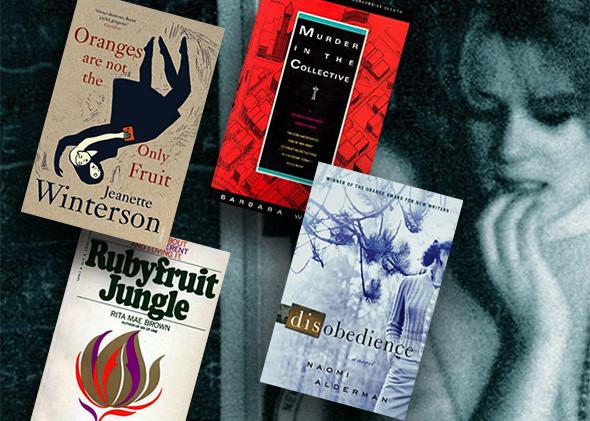If you’re coming out and looking for stories about women whose lives you’d like to emulate (or avoid), wanting to learn more about the lesbian community so you can support a friend or relative, or just looking for a good read, look to lesbian fiction. This list of my personal favorites reflects when I came out—the early 1980s. That just makes these books classics, right?
The Price of Salt, by Patricia Highsmith. Today she is best known for Strangers on a Train, the Tom Ripley novels, and her vile, anti-Semitic beliefs, but Patricia Highsmith is also responsible for one of the first lesbian love stories with a happy ending. Not that the closeted writer took credit: The Price of Salt appeared in 1952 under the name Claire Morgan, but Highsmith didn’t acknowledge authorship until 1984. Writing in Slate, Terry Castle described it as “a novel in which pulp-fiction plotting, ’50s paranoia, and heavy doses of authorial cynicism combined, somehow miraculously, to produce a louche and stunningly erotic McCarthy-era love story.” The book is currently being made into a movie starring Cate Blanchett—so you know you’re going to be reading it sooner or later.
Shockproof Sydney Skate, by Marijane Meaker. My favorite novel about coming out is told from the point of view of a 17-year-old boy who knows his mom is a lesbian, even though she’s still trying to protect him from that knowledge. She always speaks in code when he’s around, but Sydney broke the cipher years ago. Set in Manhattan and the Hamptons at their most glamorous, Shockproof Sydney Skate is funny, touching, and delightfully messy. (Meaker, who wrote dozens of lesbian pulp novels in the 1950s and ’60s, was involved with Patricia Highsmith for two tempestuous years, and her memoir of the relationship, Highsmith: A Romance of the 1950s, is also a great read.)
Rubyfruit Jungle, by Rita Mae Brown. Before she was known as the author of best-selling mysteries in which cats solve crimes, Rita Mae Brown wrote the classic most likely to by read by young women questioning their sexuality. Forty years after it first appeared, Rubyfruit Jungle seems a little tame, but the story of a bold, beautiful bastard is still irresistible.
Oranges Are Not the Only Fruit, by Jeanette Winterson. Winterson’s breakthrough autobiographical novel is her best. Like Rubyfruit Jungle, it’s the story of a strong young woman standing up for herself against people and forces—in this case, Pentecostal religion—that think she needs fixing because she loves women. Although the story it tells is largely true, the book is strange, beautiful, and often poetic. (After you’ve read Oranges, check out Winterson’s memoir Why Be Happy When You Could Be Normal?, which tells the real-life story behind the novel.)
Relatively Norma, by Anna Livia. That Anna Livia failed to become a household name is one of the great failures of feminist publishing. Livia was born in Ireland, grew up in Africa, and lived her later years in the United States (she died unexpectedly in 2007 at the age of 51), but it was the years she spent in London in the 1980s—some of it toiling in the world of feminist publishing at Onlywomen Press—that produced her most tart and touching work. Relatively Norma, the story of a young British lesbian visiting her mother in Australia, is one of her funniest books. In it, all the men are named John.
Disobedience, by Naomi Alderman. I would never have thought that a book whose chapters begin with passages of biblical exegesis would be among my favorite novels, but Alderman’s story of two women growing up in London’s Orthodox Jewish community is intense and beautifully written.
Tipping the Velvet, by Sarah Waters. Waters is everyone’s favorite lesbian historical novelist, and Tipping the Velvet is the most irresistible of her books. In this novel set in the Victorian world of oyster shuckers, female impersonators, and passing women, the lead character lives more lives than a cat.
Stone Butch Blues, by Leslie Feinberg. One of those rare novels that launches a revolution. When Stone Butch Blues first appeared in 1993, transgender issues were rarely discussed in feminist circles. Feinberg’s telling of Jess Goldberg’s journey from bar butch to someone who lives in the world as a man changed all that. (For women who identify as femmes, Joan Nestle’s A Restricted Country served a similar function.)
Barbara Sjoholm’s Pam Nilsen and Cassandra Reilly mysteries. In the 1980s and early 1990s, lesbian and feminist literature experienced a mystery boom. All over the world, people were reading about lesbians solving murders, and Barbara Sjoholm (who was known as Barbara Wilson when the books first appeared) was a genre pioneer. The Pam Nilsen mysteries (Murder in the Collective, Sisters of the Road, and The Dog Collar Murders) were set in the feminist collectives and activist circles of Seattle, while Cassandra Reilly (Gaudí Afternoon, Trouble in Transylvania, The Case of the Orphaned Bassoonists, etc.) conducted her investigations in more exotic locales.
Radclyffe’s Honor series. Although I reject the notion of guilty pleasures, I’m not sure how else to describe my affection for Radclyffe’s soapy series about the love affair between Blair Powell, the president’s daughter, and Cameron Roberts, the head of her Secret Service detail. As I wrote back in 2009, “In the course of the series, Cam is shot, burned, blown up, hit by a car, and almost drowned, while Blair evades bullets, bombs, anthrax, and breast cancer. In between these aggravations, the two of them negotiate the boundaries of protection and freedom and enjoy a tremendous amount of mind-blowingly awesome sex.”
